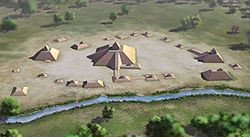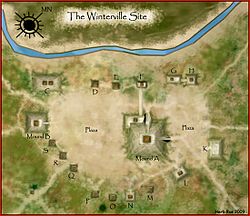Winterville site facts for kids

Artist's conception of the Winterville site
|
|
| Location | Washington County, Mississippi, |
|---|---|
| Region | Washington County, Mississippi |
| Coordinates | 33°29′9″N 91°3′40″W / 33.48583°N 91.06111°W |
| History | |
| Abandoned | 1450 |
| Periods | Winterville Phase |
| Cultures | Plaquemine Mississippian culture |
| Site notes | |
| Excavation dates | 1967 |
| Archaeologists | Jeffrey P. Brain |
| Architecture | |
| Architectural styles | platform mounds, plazas |
| Architectural details | Number of mounds: 23 |
|
Winterville site
|
|
| NRHP reference No. | 73001031 |
| Significant dates | |
| Added to NRHP | August 17, 1973 |
| Designated NHL | September 14, 1993 |
| Responsible body: State | |
The Winterville site is a very important archaeological site in Washington County, Mississippi, USA. It is located north of Greenville near a river. This ancient place has many large earthwork monuments. These include more than twelve huge platform mounds and flat, open areas called plazas.
The site is known as the main example for the Winterville Phase (from 1200 to 1400 CE). This phase is part of the Plaquemine Mississippian culture in the Lower Yazoo Basin. Today, Winterville is a state park and has been named a National Historic Landmark.
In June 2015, the state approved $300,000 to fix up the mounds. This money helped restore them to how they looked before Europeans arrived. The park also added walking trails. There is also a museum at the site where you can learn more.
Contents
Exploring the Winterville Mounds
The Winterville Mounds are named after the nearby town of Winterville, Mississippi. This site was once a special religious and political center. It was built by Native Americans of the Plaquemine culture. This culture was a local version of the larger Mississippian culture. These civilizations were very active from about 1000 to 1450 CE.
The earthwork mounds were a key part of the Winterville society's beliefs and government. They were used for sacred buildings and ceremonies. Most of these mounds were built between 1200 and 1250 CE. Scientists have found that the Winterville people mostly lived on family farms. These farms were spread out across the Yazoo-Mississippi River Delta basin. Only a few important leaders lived at the mound center itself.
The Winterville ceremonial center originally had at least twenty-three platform mounds. These mounds surrounded several large, flat plazas. Some mounds outside the park were flattened for farming or roads before the site became a protected state park.
Today, twelve of the largest mounds are being preserved. This includes the 55 feet (17 m) tall Temple Mound. The Mississippi Department of Archives and History and the University of Mississippi are working on a long-term plan. In June 2015, money was approved to restore the mounds. This involved removing trees and brush. Two new walking trails were also added to the park.
Archaeologists have found links between the Winterville Mounds residents and the later Natchez Indians. French explorers wrote about the Natchez in the early 1700s. The Natchez society had different social ranks. A person's rank was passed down through the mother's family, which is called a matrilineal kinship system. The chief and other leaders inherited their roles. This strong leadership helped organize the building of the Winterville mounds. However, there is not much evidence of many people living at the site. This suggests it was mainly used for special ceremonies.
A big fire destroyed the main building on the Temple Mound in the late 1300s. Scientists are still not sure what caused this fire. People continued to use the site afterward, but no new mounds were built. The number of people living at Winterville slowly went down. At the same time, more people moved to settlements about 50 miles south. By 1450 CE, the Winterville Mound site seemed to be completely empty. The time when the site was most active (1200 to 1400 CE) is called the Winterville Phase by archaeologists.
The first modern digs at Winterville happened in the 1940s. These were done by the National Park Service and Harvard University. Jeffrey P. Brain led more excavations in 1967. His report, Winterville: Late Prehistoric Culture Contact in the Lower Mississippi Valley, was published in 1989. They found burials, building remains, and items like pottery and stone tools. You can see some of these items at the Winterville Museum in the park.
Winterville Mounds became a Mississippi state park in March 1969. It was named a National Historic Landmark in 1993. The mounds are also part of the Mississippi Mound Trail.
Ancient Cultures and Time Periods at Winterville
This table shows the different cultures and time periods that were important at the Winterville site. It helps us understand how the area changed over many centuries.
| Culture or cultural tradition | Phase | Dates |
|---|---|---|
| Mississippian | Russell (Tunica) | 1650 CE to 1750 CE |
| Wasp Lake | 1500 to 1650 CE | |
| Lake George | 1400 to 1500 CE | |
| Plaquemine | Winterville | 1200 to 1400 CE |
| Coles Creek | Crippen Point | 1050 CE to 1200 CE |
| Kings Crossing | 950 CE to 1050 CE | |
| Aden | 800 CE to 950 CE | |
| Baytown | Bayland | 600 to 800 CE |
| Deasonville | 400 CE to 600 CE ? | |
| Marksville | Issaquena / Paxton | 200 to 400 CE? |
| Anderson Landing | 0 CE to 200 CE? | |
| Tchefuncte | Tuscola | 400 to 0 CE ? |
| Poverty Point | McGary | 900 BCE to 400 BCE ? |
| Jaketown | 2000 BCE to 900 BCE ? |
Pottery from Winterville
The people of Winterville made pottery by hand. They built up strips of clay, then smoothed them out. This was a common way to make pottery in Eastern America, as they did not have a potter's wheel.
They mixed things like ground mussel shells, grit, or small bits of clay into the pottery. This made the clay stronger. The finished pottery could be roughly polished or very smooth and shiny. They made many shapes, from shallow bowls to tall jars. Some pieces even had animal shapes as handles. The decorations ranged from plain to detailed designs from the Southeastern Ceremonial Complex.
Most of the pottery found at Winterville is known as Addis Plain var. Addis, Addis Plain var. Greenville, and Addis Plain var. Holly Bluff. Some Mississippian culture pottery found here was brought from other Mississippian groups. These might have come from places like Cahokia or areas influenced by Cahokia. Examples include pottery from the Nodena Red and White var. Dumond and Walls Engraved var. Walls. These pieces had special red and white colors, thinner walls, and a finer finish. They were likely valued because they were unique and well-made.
See also





